Click Here to see full-size infographic

Becky's foray into the hyperlinked library mindset
Click Here to see full-size infographic

For this assignment, I am using my current library as my muse.
The Human Connection (cue Kermit the Frog)
Infinite Learning is the concept of learning through curiosity wherever and whenever you are and using whatever resources are available, which may or may not include technology. In the video The Adaptable Mind (2015), they suggest that STEM (Science, Technology, and Math) not only should include Arts, making it STEAM, but it should include Humanity, making it SHTEAM!

They go on to state that “human is the one quality that machines don’t have.” (Tiffany Shlain & Let It Ripple Studio, 2015). To be an infinite learner we must embrace our curiosity. Brain science tells us that curiosity stimulates the learning, memory, and reward centers of the brain. (Curiosity Helps Learning and Memory | University of California, 2014).
In The Heart of Librarianship (2016), page 140, Michael Stephens addresses the concept of “Learning to Learn”. (HeartofLibrarianship.Pdf, n.d.). This is not just a concept to share or to project onto our library patrons, but one to embrace as a librarian. Am I open to learning new things? Do I take professional development to heart? Does the energy from staff development days last? Am I growing personally?
If there is one thing libraries have in abundance (besides books and information resources) it’s heart, the epicenter of human connection. As a program librarian, I take these lessons, well, to heart.
This is me, embracing “Messy Learning”. (Block, n.d.)
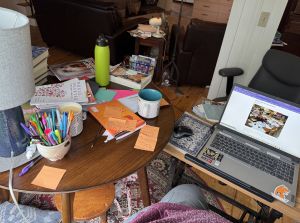
References
Block, J. (n.d.). Embracing Messy Learning. Edutopia. Retrieved July 27, 2025, from https://www.edutopia.org/blog/embracing-messy-learning-joshua-block
Curiosity helps learning and memory | University of California. (2014, October 2). https://www.universityofcalifornia.edu/news/curiosity-helps-learning-and-memory
HeartofLibrarianship.pdf. (n.d.). Dropbox. Retrieved June 15, 2025, from https://www.dropbox.com/scl/fi/26cn6o86m5i0vcpcznebf/HeartofLibrarianship.pdf?dl=0&rlkey=ozp68co4gmafmfvcu2tv4ec7p
Tiffany Shlain & Let It Ripple Studio (Director). (2015, October 8). The Adaptable Mind (11 min Cloud Film) [Video recording]. https://www.youtube.com/watch?v=937iCwJd3fI
There are two powerful storytellers that came to mind while reviewing the resources for this module. Paul Harvey and Mike Rowe. Both with unique, unforgettable, and immediately distinguishable voices. Paul Harvey was a highly decorated television and radio news man with a popular radio show called “The Rest of the Story”. (The Rest Of The Story, n.d.). He told stories of everyday people, but in a way that left you hanging, waiting for the other shoe to drop, and then it did, and it was “the rest of the story”.
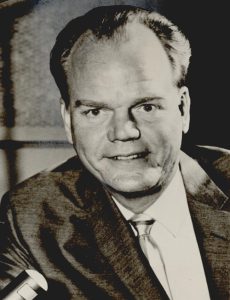
HARVEY, PAUL/ NEWS COMMENTATOR & COLUMNIST: Paul Harvey ” Campaign Roundup”: Caption reads, News commentator Paul Harvey, winner of the “Fourth Estate Award” as top radio-TV newsman for 1965, will speak to the Men’s Dinner Club at 6:30 p.m. Monday in the Skirvin Tower Hotel’s Persian Room. Photographer UNKNOWN. Original Photo 04/07/1960. Published on O-12-13-65.
Mike Rowe, best known for his television series, “Dirty Jobs”, also tells stories about everyday people through his podcast, “The Way I Heard It” (“Home,” 2025). Mike Rowe is an ally to and advocate for those who work with their hands. He encourages young people to consider trades and hard work outside of the desk and computer fields. His stories, much like Paul Harvey’s, leave the listener uplifted, enlightened, and often amused.
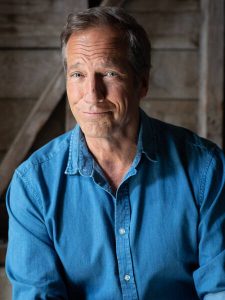
Two other modern-day storytellers come to mind as well, Elias Weiss Friedman, better known as “The Dogist”, and Brandon Stanton, the human behind “Humans of New York.” The Dogist wanders the city finding humans and their dogs. He stops them and asks if he can photograph the dog. Folks are generally very happy to allow it. Elias asks them questions about the dog’s breed, their name, how the person acquired them, and whatever else they want to share about the dog. The pictures are always so sweet and moving as is the video of him taking the photos. (The Dogist, n.d.).
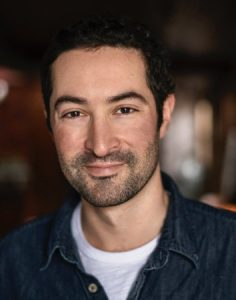
Brandon Stanton has a similar approach to capturing everyday life in a profoundly moving way. Just a picture. It really does say a thousand words, or more. (Brandon Stanton | Photographer & Author, n.d.).
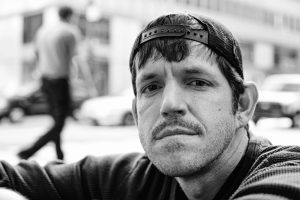
Wollongong, Australia’s “Meet Our Living Books” (Wollongong Living Books | City of Wollongong, n.d.) and Anythink’s “Get to Know Your Neighbor” couch conversatons (Anythink Libraries, 2016) are two great examples of story sharing as facilitated by the public library. The library is a Third Space, somewhere free to visit, free to stay all day (when they are open), and free to check out materials (at least generally). At our library, where I work in Youth Services, we put up the old, brightly painted wooden puppet theatre along with a trough full of all kinds of puppets (animals and people including different genders and skin tones). It has been the biggest hit for our community. The kids know exactly what to do and they do it together with other kids who are strangers. Parents, siblings, grandparents, and caregivers all get into the act. The storytelling that happens is extemporaneous and genuine.
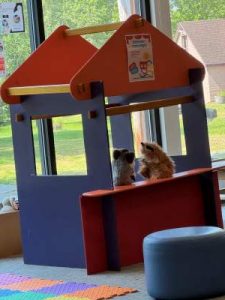
Everyone has a story. Either made up or true about their past (or still made up!) Everyone wants to be heard. Finding unique ways to encourage self-expression at all age levels is at least as important for librarians as are the collections we curate.
References
Anythink Libraries (Director). (2016, December 21). Get To Know Your Neighbor [Video recording]. https://www.youtube.com/watch?v=rzLI-aqFzDQ
Brandon Stanton | Photographer & Author. (n.d.). Brandon Stanton. Retrieved July 19, 2025, from https://www.humansofnewyork.com
Elias Weiss Friedman | Penguin Random House Canada. (n.d.). Retrieved July 19, 2025, from https://www.penguinrandomhouse.ca/authors/2299401/elias-weiss-friedman
Home. (2025, July 16). Mike Rowe. https://mikerowe.com/
The Dogist. (n.d.). YouTube. Retrieved July 19, 2025, from https://www.youtube.com/channel/UCLhKvwRxjSpUV25iqBTzbUQ
The Rest Of The Story. (n.d.). [Video recording]. Retrieved July 19, 2025, from https://www.youtube.com/watch?v=S5_OIoMBjSk
Wollongong Living Books | City of Wollongong. (n.d.). Retrieved July 19, 2025, from https://wollongong.nsw.gov.au/my-community/events-and-programs/living-books
New Models/New Horizons Reflection
While contemplating the readings and resources for the past two modules on New Models and New Horizons, I decided to throw a question into our school-supported ChatGPT tool just to see what it would say. The question, “what will the public library of the future look like?” elicited an in-depth response that sounds like all the information offered in this course, lectures and links. The short version looks like this:
It followed up asking if I would like to see a rendering of what the future library might look like. Here is what it produced:
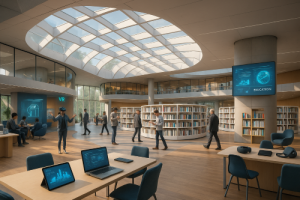
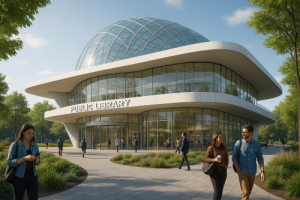
There is a lot that could be deconstructed from these images, not the least of which is the lack of diversity among the people.
ChatGPT’s summary says, “Future libraries will be platforms for opportunity, not just repositories of books. They’ll support digital equity, creativity, civic life, and lifelong learning, ensuring no one is left behind in an increasingly digital world.” (ChatGPT, n.d.)
Two library models really stood out to me in these last modules, Storyhouse in England and Anythink libraries in Colorado. The amount of foresight and inspiration that it must have taken to build these places and services is mind blowing.
Rangeview Library District rebranded to Anythink in 2009! (Anythink Libraries, 2016). I’m sorry to say that I never visited Anythink when I lived in Colorado. (Northeastern Colorado is kind of its own country, you kind of have to decide to go there.) I really liked the video of the “Get to Know Your Neighbor” couch conversations. What a wonderful idea! Storyhouse is a civic-minded hub of creativity of which the library is only a part. The spaces and programs are innovative and inspire community and connection. (Home | Storyhouse, n.d.)
These kinds of libraries remind us of the importance of a deeper understanding of the wants and needs, spoken and unspoken, of the communities we serve. Tapping into creative services, programs, and events on top of a well-planned infrastructure for facilitating information needs is the way to establishing a solid community-minded institution.
References:
Anythink Libraries (Director). (2016, December 21). Get To Know Your Neighbor [Video recording]. https://www.youtube.com/watch?v=rzLI-aqFzDQ
ChatGPT. (n.d.). Retrieved July 14, 2025, from https://chatgpt.com
Home | Storyhouse. (n.d.). Retrieved July 14, 2025, from https://www.storyhouse.com/
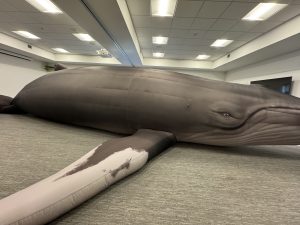
Have you ever seen the inside of a Humpback whale? Allow me to introduce Chomp. She is a blow-up replica of a real whale from the shores of Maine. She visited us in the library today. To see images from the inside and to learn more about Chomp, visit her website at THIS LINK. This life-size science that meets core standards and enthralls patrons of the library is one giant hyperlink!
Another example of the human hyperlink is our Friday Social Walks. Every Friday, community members meet up at the library at 9 am and take a 30-minute stroll around the wonderful trails in our town. A low-cost, high impact program that leverages community connections. These are micro-hyperlinks.
The resources in our Hyperlinked Environments module are examples of macro-hyperlinks. Wonderful, innovative programming like the HIVE in Spokane, Washington; a place with a specific purpose and found in a different part of town from the main library (The Hive – Spokane Public Library, n.d.). The “Noise Closet” in Chattanooga, a place where rock band instruments can be borrowed (jmyers, 2023). And then there’s the Memphis Sound Connection, a super groovy collection of current local music in multiple genres available for streaming right from the site. (Memphis Sound Connection, n.d.). What these examples all have in common is a deep connection to the identity and information needs of their community. Making cool connections and exciting programming is great, but if it’s not what the community needs or wants it may be a waste of time and resources. This is nothing new, of course, but it bears repeating and remembering.
The reading that really stood out to me in this module is “Experts Say the ‘New Normal’ in 2025 Will Be Far More Tech-Driven, Presenting More Big Challenges”. Written in 2021, the article reports on where experts feel society is going in terms of connectivity. Now that it is 2025, it seems the experts were right, for the most part. They predicted that economic inequality would worsen, big technology firms would have enhanced power, and that misinformation would be multiplied. On the positive side, the experts predicted new reforms aimed at racial justice and social equity, enhancements to the quality of life for many families and workers, and enhanced technology that help people lead “smarter, safer, and more productive lives”. I believe a case can be made on all these points. Maybe not in every part of the country and certainly to different degrees. One of the things I remember distinctly about Jr. High school was a “life” class where we learned how to write checks. I have written thousands of checks in my life, paying bills monthly from age 20 to about 50 when things started becoming available to pay online. Now, I just use an app. It’s often simple, though sometimes frustrating, but so much better than sitting down at the kitchen table with a checkbook and handwriting every bill, and the envelopes and stamps. I see a big difference from 2021 to now in the ease of paying bills – it’s getting too easy to spend money! I recall a few years ago pulling up Amazon at a stoplight and making a “purchase now” buy to replace my wallet. A $40 purchase in a matter of minutes, with time to spare before the green light. I once purchased a vinyl album while waiting for the bank teller to send my receipt back out to me after depositing a check in in the drive through. It really is a brave new world.
(note: I don’t recommend shopping while driving.)
References:
jmyers. (2023, January 20). Noise Closet—Library. https://chattlibrary.org/noise-closet/
Memphis Sound Connection. (n.d.). Retrieved June 30, 2025, from https://memphis.musicat.co/
The Hive—Spokane Public Library. (n.d.). Retrieved June 30, 2025, from https://www.spokanelibrary.org/hive/
SCATTERED THOUGHTS
Librarians in Action:
This past Saturday, our community hosted its 2nd Annual “Falmouth Days” event in Community Park where vendors, non-profits, food trucks, and more were gathered to bring the community together. I’ve been to events like this before, and manned library booths for a library at events like this. I’ve only been with FML (yes, we are amused by our acronym) since January of this year, so it was my first time at Falmouth Days. Rain aside, I had the pleasure of witnessing our Community Outreach Director do her job, really well. She connected with folks in a very laid-back way, asking thoughtful questions and finding ways to demonstrate how we can be mutually beneficial. She listened more than she spoke, and she found that all-important connection. Such an artful approach, I was impressed. “Hyperlinks are people, too.” (Hyperlinked Communties, n.d.)
Digital Gatekeepers
The first library I worked in, (and the one that opened my eyes to the career of youth services; who knew that was a job? I didn’t!), was a department of the city. This was in 2012. I didn’t even have a “smartphone” at this point. Typical Microsoft products were the only digital tools available to us. Anything related to the internet, the website and then eventually a Facebook page, were all carefully controlled and came out of the city’s IT Department. When I left there in 2018, we still had the same digital tools – six years later. Imagine my surprise when I started my MLIS in 2023 to see so much out there. Many of our readings this week are dated back to 2014. I was very interested in the article on “Reading Maps” (Rendón, 2013) only to find their links no longer work. I couldn’t see the reading map. This exciting “new” idea to me had been written about when I was only one year into my first job as a librarian. While I was figuring out how to make a poster with Publisher, they were creating living documents with hyperlinks.
Implicit Bias
The reading that stood out most to me this week was “What World are We Building” (boyd, 2016). Our digital connectedness is essentially a magnifying glass. We have the same prejudices, biases, and frames of thought, but now they can be shared with the entire world. When we create tools, both physical and digital, they can be used to create, help, even heal, but they can also be used to manipulate, control, strike fear. “When the data you input is biased, what you get out is just as biased. These systems learn the biases in our society, and they spit them back out at us.” (boyd, 2016). This reminds me of the only thing I remember from my required computing class in college, circa 1986, “Garbage In : Garbage Out”.
After my first library job, I worked as an administrative assistant for a medical university (it’s there I got the courage to go for my MLIS). I was there 2019-2024, during the time diversity, equity, and inclusion (DEI) was ramping up at universities and other institutions. The prevailing attitude of the doctors, other instructors, and staff seemed to be a collective eye roll. “Of course, we believe everyone should have the same opportunities.” But our administration did a good job of choosing quality training. I soon found I was learning so much about myself and others. I was able to identify, label, and learn how to work through my biases. I was encouraged to share my enthusiasm with others. I think humans just don’t like being told something is mandatory or required. I can’t speak for anyone else, but that training was transformational for me.
Bringing it All Together
Saying we are open to all, that everyone is welcome, and having a mission statement that embodies that is meaningless if we don’t build the culture to sustain it. I’d love a follow up to the Multnomah piece, “Creating Conditions for Equity to Flourish” (American Library Association, 2019). What an inspirational story. My current library is similar in that it serves a more affluent, white, demographic. But we know there are others in the community who are underserved. They are there, but the connections and culture need to be optimized. “We need to shift our focus from collections to connections.” (WEVE, 2014).
Resources
American Library Association (Director). (2019, June 17). Multnomah County Library: Creating conditions for equity to flourish [Video recording]. https://www.youtube.com/watch?v=SKGlxh-zc0Y
boyd, danah. (2016, October 21). What World Are We Building? Data & Society: Points. https://medium.com/datasociety-points/what-world-are-we-building-9978495dd9ad
Hyperlinked Communties. (n.d.). [Video recording]. Retrieved June 29, 2025, from https://sjsu-ischool.hosted.panopto.com/Panopto/Pages/Viewer.aspx?id=3eacdb23-84fd-49e5-9975-aef3014b3ed2
Ingle, M. & Pewhairangi, S. (2014, May). WEVE. https://287.hyperlib.sjsu.edu/wp-content/uploads/2014/06/WEVE_May_2014.pdf
Rendón, J. N. (2013, December 12). Reading Maps: Readers’ Advisory on Steroids – Public Libraries Online. Public Libraries Online – A Publication of the Public Library Association. https://publiclibrariesonline.org/2013/12/reading-maps-readers-advisory-on-steroids/
“Do people actually come to the library?” he said, with a sense of wonder and a tinge of amusement. “Um, yes, yes, they do,” I replied before continuing to explain the kinds of programs and services we offer. This was the scene just a few short weeks ago when I was having an ingrown toenail removed. The doctor was not just surprised but honestly amused as if having a warm memory from his childhood. He then said, “everything’s available online.” Well, not exactly, doctor, I said in my mind, trying to find some coherent way of summarizing the vitality of modern libraries. Of course, there was no time for more discourse. His job was done, “if it grows back, come back in and we’ll treat it with a special solution,” and he walked out the door chuckling to himself.
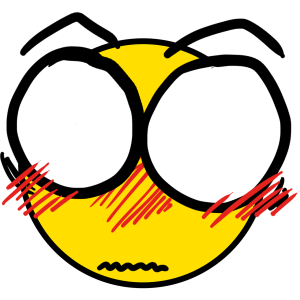 image from Pixaby
image from Pixaby
If ever there was motivation to work on my elevator speech, this would be it!
It never ceases to amaze me how vastly different libraries can be. Even in the same city, urban area, state, or country. Each one seems to have some semblance of the same mission, to make information of all kinds available to their community. Many share similar Vision Statements citing the need for robust collections of information for their users. The differences start to appear when looking at exactly what kinds of information is collected and how these mission(s) and vision(s) are implemented. That’s what it comes down to, the “what” and the “how”.
Denning (2015) addresses this very concept, suggesting LIS professionals find ways to see things anew. He quotes French novelist, Marcel Proust, “The real voyage of discovery consists not in seeking new landscapes but in having new eyes.” We, LIS professionals, need to “recognize the future that is already unfolding right in front of us.” So, this helps inform the “what” we need to do, but still, the “how” remains. This is where the differences in libraries become their strengths. The “how” will depend on the users being served. As part of my Materials for Young Adults class, I recently sat in on a zoom presentation with New Hampshire Young Adult librarians, Lucia von Letkemann and Julia Lanter. They noted that at one time, they were at libraries not a 15 minutes’ drive from one another. When discussing collection development and programming for their teens, they couldn’t be more different. In fact, when they would weed their collections, they would reach out to each other as their patrons were often clamoring for the materials from the other library. Knowing our communities is the first step to discovering the future that is already here.
As the person who is the one not only coming up with ideas but executing them, hopefully successfully, it is hard for me to look at things from a more philosophical perspective. I’m down in the trees, following my nose, doing what needs to be done day to day. Classes like this one encourage us to look at the big picture, discuss theories, point at great models and maybe at failures as well. We’re examining the forest, while yet stuck in the trees.
For clarity, we can look to visionaries such as our professor, Michael Stephens, who encourages shifting our view of library resources to include the people we serve, not just the technologies that serve them. Making the information center not just a place to consume information, but one where people can collaborate and create. (Stephens, 2019). Often we look to fill needs and serve the disenfranchised, but the “have-nots” can benefit by a more inclusive and inter-participatory library model that services the “haves” as well. (Mattern, 2014). Reflecting a community’s character back to itself, will clarify its identity, especially if it is a well-designed and contextually-designed library. (Mattern, 2014).
Resources:
Denning, S. (n.d.). Do We Need Libraries? Forbes. Retrieved June 15, 2025, from https://www.forbes.com/sites/stevedenning/2015/04/28/do-we-need-libraries/
HeartofLibrarianship.pdf. (n.d.). Dropbox. Retrieved June 15, 2025, from https://www.dropbox.com/scl/fi/26cn6o86m5i0vcpcznebf/HeartofLibrarianship.pdf?dl=0&rlkey=ozp68co4gmafmfvcu2tv4ec7p
Mattern, S. (2014). Library as Infrastructure. Places Journal. https://doi.org/10.22269/140609
I’m attempting to embed my video, but it’s not cooperating.
I chose this class because I know the information will be very useful in my career. Michael is a fantastic teacher, so I know this will be a great experience!
About Me for INFO 287 #hyperlib by Becky Steenburg
© 2025 Hyperlinked Hijinks
Theme by Anders Noren — Up ↑